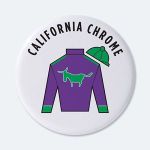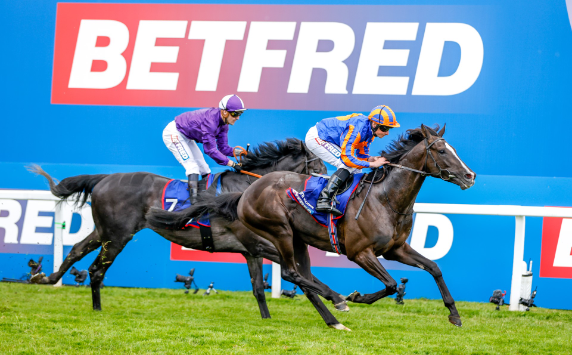As the National Sales approach, there are a lot of ads with bold claims to various things, family trees and ancestors recanted back to the nth generation and any number of facts and figures. I’m not saying facts and figures aren’t good. Numbers are how we keep track of things and analysing numbers is how we quantify and make sense of how those things are (or aren’t) performing.
A rather clever and well respected man by the name of Dr H James Harrington, is credited with saying “Measurement is the first step that leads to control and eventually to improvement. If you can’t measure something, you can’t understand it. If you can’t understand it, you can’t control it. If you can’t control it, you can’t improve it.” Harrington has authored over 35 books, created 10 software packages on performance improvement and is considered one of the world’s leading performance improvement gurus. If he says it, then it must be true!
A good horse is never a bad colour
I learnt that lesson the hard way. I often joke that I’m not a fan of chestnut horses, with chestnut fillies languishing on the bottom of my favourites list. This rather irrational bias is rooted in a bad childhood experience and hell may have no fury like a woman scorned, but I can vouch that the child dumped by a pony has an equally long memory! When it came to breeding my own horses, I had rather firm ideas of what I wanted and it was summed up in one word: ‘bay’. I increased my chances by starting off with a bay mare, but it took me a while to realise that the chestnut gene is a recessive one and that a horse might look bay, but can still carry the genetic material for producing chestnut offspring. And despite recessive sounding as though it should be a rather rare occurrence, it’s amazing how often two recessive genetic combinations seem to meet. While I was figuring this out, I managed to end up with 2 chestnut fillies and a chestnut colt. But such is life and sometimes your horses choose you.
Of course, one of the joys of life and particularly of racing is that occasionally, for no apparent reason at all, some individuals seem to take a pass on abiding by the rules and simply make up their own as they go along. I won’t get too excited just yet, but there is just a whiff of possibility that we may be witnessing one of those extraordinary situations where reality waves two fingers at the form book and simply does its own thing. It’s an American story and I understand that everyone is focussed on either sales prep or the forthcoming Champions Day, but for those with a few minutes to spare, grab a mint julep and a comfy chair, we’re off to the Kentucky Derby!
Unlikely hero
Meet California Chrome, a big flashy chestnut owned in partnership by Perry and Denise Martin and Steve and Carolyn Coburn under the name DAP Racing. The couples met through a horse ownership group called the Blinkers On Racing Stable run by Scott Sherwood and each owned a five per cent share in a filly called Love The Chase. The filly had 6 career starts for a total of 1 win and $7,020 in earnings. Trainer Greg Gilchrist describes her as follows: “She wasn’t very big, and she did not continue to grow at all,” Gilchrist said. “When I put the saddle on and can look the valet straight in the eye, that’s not a good sign. I ran her twice, and I told Mr. Sherwood the filly just didn’t have any talent. She’ll try all day long, but she just can’t run. When she won it had to be the slowest maiden race in California that year. If anybody but Perry Martin would have bought her, she probably would have ended up in a 4-H club somewhere.”

California Chrome silks
As it turned out, some little kid’s loss proved to be racing’s gain. When Blinkers On dissolved, both couples wanted to buy the filly so they ended up forming a partnership. They paid $8000 for her in the hope that she might make a good broodmare. On hearing they were purchasing Love The Chase, a horseman nearby remarked that only a “dumb ass” would purchase her, so they named their partnership DAP Racing, “Dumb Ass Partners.”
Love The Chase was booked to $2,500 California stallion Lucky Pulpit and duly produced a chestnut colt with flashy white markings. Despite being a first foal, he weighed in at a hefty 62kgs at birth and was originally called ‘Junior’. The partners chose his racing name at a restaurant by writing several potential names on pieces of paper and asked a waitress to draw one out of a hat. The emerald and purple of their racing silks are their wives’ favourite colours and they created a caricature of a jackass to go on the back of their silks. The initials “DAP” are stitched on California Chrome’s blinkers and on the front of the silks.
Finding a trainer
When the colt was ready, the partners approached Art Sherman to train their “Derby horse”, presenting him with a schedule of races that would get them to Churchill Downs. Sherman must have been amused, but he liked the folks and their enthusiasm and agreed to take the horse.
77 year old Art Sherman has a story too. A jockey for 23 years before turning his hand to training, he’s not what one might call a big time trainer, but he has been to Churchill Downs before. Nearly 60 years ago, 18 year old Sherman worked as an exercise rider for Rex Ellsworth, who assigned him to 1955 Derby winner, Swaps! Sherman trains with his assistant son Alan and they work out of Los Alamitos Race Course, which is generally regarded as a track for Quarter Horse racing and minor Thoroughbred claiming races. However, with the closure of Hollywood Park Racetrack last December, Los Alamitos inherited some of the yards from Hollywood Park, including Sherman. Los Alamitos will host all-Thoroughbred meets for the first time in 2014, so the track manager is particularly happy about the success of California Chrome and his ability to bring good publicity to their track, saying, “having Art’s horse here, it jump-started our credibility.”
Career so far
In his 2yo debut, California Chrome finished a 1-length second at Hollywood Park in April 2013. Three weeks later, he won his second start by 2 ¾ lengths, partnered by Alberto Delgado on both outings. A poor showing in the Willard L Proctor Memorial Stakes under jockey Corey Nakatani prompted a six-week break and then the team tried their luck at Del Mar with original rider Delgado back on board. He won the Graduation Stakes by a solid 2 ¾ lengths and then finished sixth against graded stakes company in the Gr1 Del Mar Futurity. Two months later, the colt cantered down for the Golden State Juvenile Stakes at Santa Anita on 1 November. He got out of the gates last and struggled throughout the race, fading at the end, however his trainer maintained his faith in him, taking the view that he was still growing and learning how to be a race horse.
And how right he proved. California Chrome returned to Hollywood Park on 22 December for his final start of the year in the King Glorious Stakes. With Victor Espinoza in the saddle, the colt posted a decisive 6 ¼ length victory, becoming the final stakes winner at the track before it closed. Sherman liked the way Espinoza rode the colt and has kept him on board ever since.
California Chrome kicked off his 3yo season with the California Cup Derby on 25 January. Starting second favourite, he was slow out of the gates, but recovered quickly to win by an easy 5 ½ lengths. Sherman noted that it was the second race in a row where the horse pulled clear and won by a decisive margin, stating, “It’s like the light bulb has gone on.” His first graded stakes win followed in his next start, the Gr2 San Felipe Stakes on 8 March. Despite starting favourite, Espinoza changed tactics, leading wire to wire and pulling away from the field to win by 7 ½ lengths. The victory earned California Chrome 50 points in the Road to the Kentucky Derby system, putting him up for contention for the Kentucky Derby.
Big offer
The colt was attracting attention and his connections turned down a $6 million offer for a 51% controlling interest, because the deal included moving the horse to a different trainer. Their decision was vindicated on 8 April when California Chrome posted his first Gr1 win in the $1million Santa Anita Derby, defeating 2 other Derby hopefuls in Hoppertunity and Candy Boy. His time of 1:47.52 was the second-fastest time in Santa Anita Derby history. Commentator Trevor Denman called him home as “Absolutely sensational” and Sherman has taken to calling the colt “my Swaps.”
“He’s got no wasted motion,” Sherman commented recently. “He’s got a good shoulder on him, and he’s real strong in the front. I always say I’d like to see a little more ass on him, but what are you going to do …. pick him apart? I’m just so happy he’s running the way he is. He is a little offset in the knee, and his right foot turns out a little. I’m always checking his knees and his ankles. Everything has been ice-cold, knock wood. When I was riding I broke my right ankle in three places, so me and the colt toe out about the same. He’s kind of freaky, and I’m enjoying it. I can’t believe the races I’ve been seeing. A length or two might have been all right with me.”
The Santa Anita Derby was run over 1 1/8 miles and jockey Espinoza was easing him back over the finish. The Kentucky Derby distance is 1 ¼ miles. When asked about the Derby distance, Espinoza commented “”I don’t think it will be a problem.”
The owners, who describe themselves as “working class people” and in a move that would leave the RA gasping, dressed down for the Santa Anita Derby. Martin wore a black shirt and black Kentucky Derby cap, and Coburn wore a tan cowboy hat and jeans. When asked how they would be celebrating their big win, Coburn said “We haven’t decided yet which McDonald’s to go to.”
Fact or fairytale
The decisive win has made California Chrome an early favourite for the 2014 Kentucky Derby on 3 May and raised speculation whether he has the talent to win the Triple Crown. The odds of course, are against it. To date only three California-bred horses have ever won the Derby: Morvich in 1922, Swaps in 1955 and Decidedly in 1962. So, California bred horses rarely win the Derby, cheap homebreds almost never and horses trained at Los Alamitos? The Triple Crown is a whole different ball park! But the journey of a thousand miles begins with one step. And horses don’t read stats. When it was pointed out that this level of racing is usually reserved for blue bloods, Coburn answered “The horse don’t know he’s no blue blood.” And perhaps he’s right. Most of the time, the facts do work and that’s probably as life should be. But just occasionally we do get a fairy tale.
I don’t usually bother too much with the American Triple Crown, but I have a feeling I might this year. And I might just shout a flashy chestnut home too.






